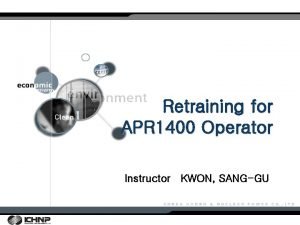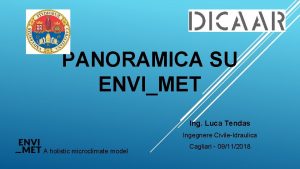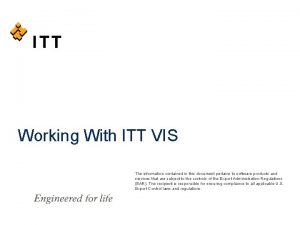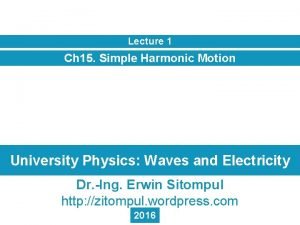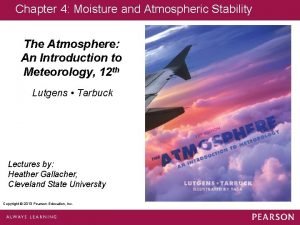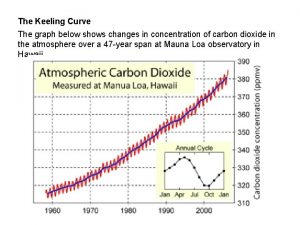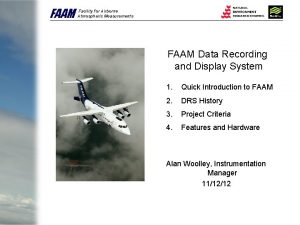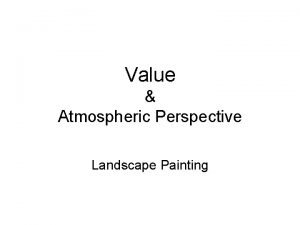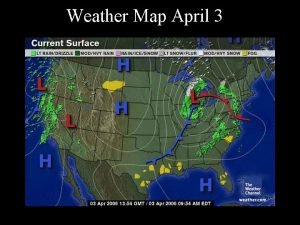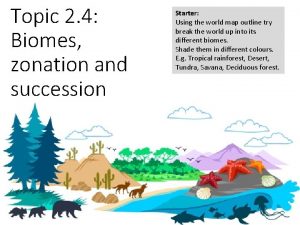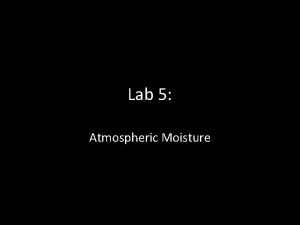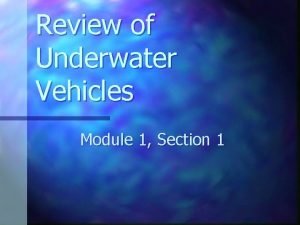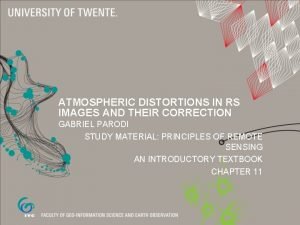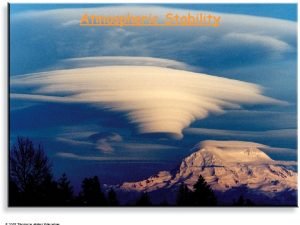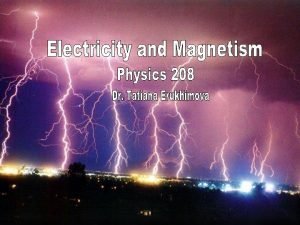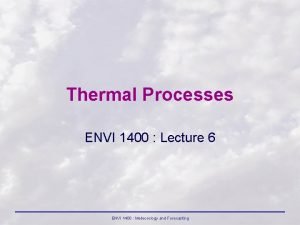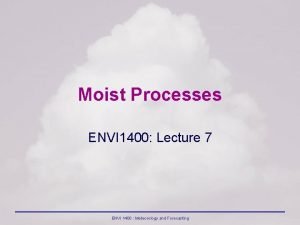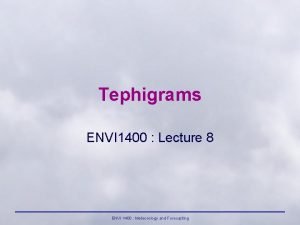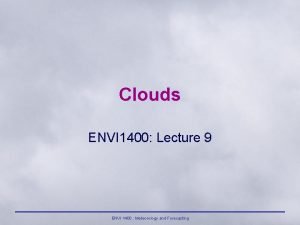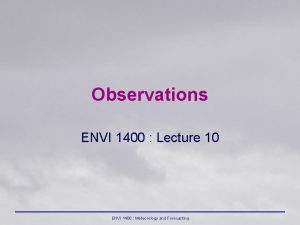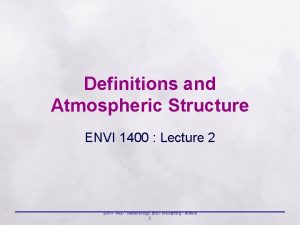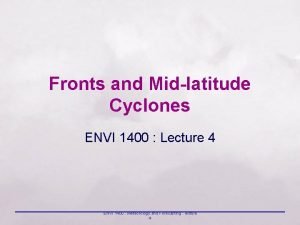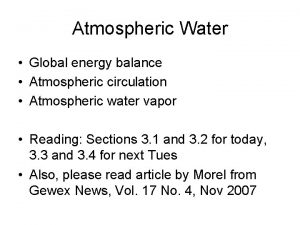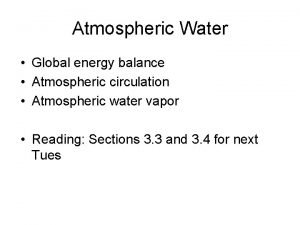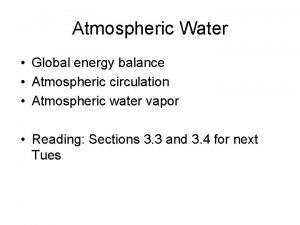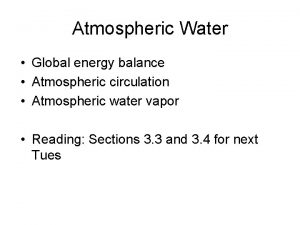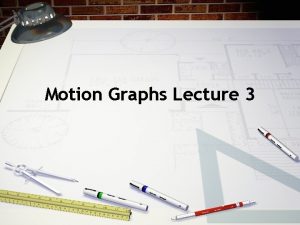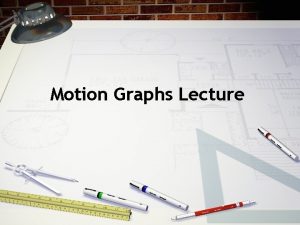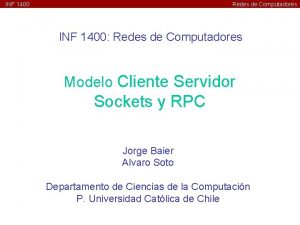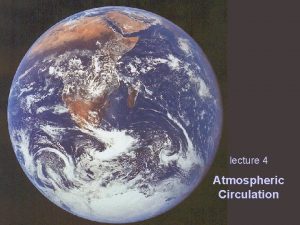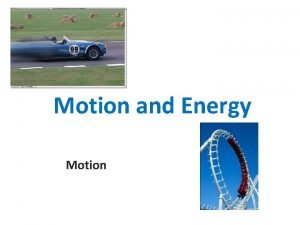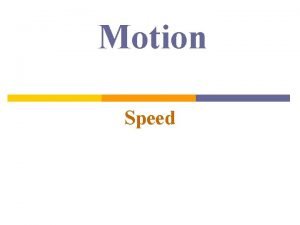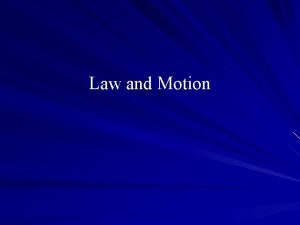Atmospheric Motion ENVI 1400 Lecture 3 ENVI 1400
























- Slides: 24

Atmospheric Motion ENVI 1400: Lecture 3 ENVI 1400 : Meteorology and Forecasting : lecture 3

Isobars at 4 mb intervals ENVI 1400 : Meteorology and Forecasting : lecture 3 2

The Pressure Gradient Force Horizontal pressure gradients are the main driving force for winds. Pressure gradient force = - 1 d. P dx where P is pressure, is air density, and x is distance. The force is thus inversely proportional to the spacing of isobars (closer spacing stronger force), and is directed perpendicular to them, from high pressure to low. 1000 mb 1004 mb pressure force The pressure force acts to accelerate the air towards the low pressure. ENVI 1400 : Meteorology and Forecasting : lecture 3 3

The Coriolis Force ENVI 1400 : Meteorology and Forecasting : lecture 3 4

The coriolis force is an apparent force, introduced to account for the apparent deflection of a moving object observed from within a rotating frame of reference – such as the Earth. Axis of spin The coriolis force acts at right angles to both the direction of motion and the spin axis of the rotating reference frame. V Coriolis Force ENVI 1400 : Meteorology and Forecasting : lecture 3 5

ENVI 1400 : Meteorology and Forecasting : lecture 3 6

Coriolis Force on a Flat Disk Fc V 1 2 3 4 5 6 ENVI 1400 : Meteorology and Forecasting : lecture 3 7

Earth is a sphere – more complex than disk: horizontal and vertical components to the coriolis force. In the atmosphere, we are concerned only with the horizontal component of the coriolis force. It has a magnitude (per unit mass) of: 2 V sin = angular velocity of the earth V = wind speed = latitude This is a maximum at the poles and zero at the equator, and results in a deflection to the right in the northern hemisphere, and to the left in the southern hemisphere. ENVI 1400 : Meteorology and Forecasting : lecture 3 8

ENVI 1400 : Meteorology and Forecasting : lecture 3 9

Geostrophic Balance A pressure gradient imposed on a stationary air mass will start to accelerate it towards the region of low pressure 1000 mb The pressure force continues to accelerate the flow, and the coriolis force continues to turn it FP FP FP 1004 mb V V Fc FP Fc The coriolis force acts to turn the flow to the right (in the northern hemisphere) Vg V Fc Fc Eventually the flow becomes parallel to the isobars, and the pressure and coriolis forces balance. This is termed geostrophic balance, and Vg the geostrophic wind speed. ENVI 1400 : Meteorology and Forecasting : lecture 3 10

Since the coriolis force balances the pressure force we have: Pressure gradient force = coriolis force 1 d. P = 2 Vg sin dx Geostrophic wind speed is directly proportional to the pressure gradient, and inversely dependent on latitude. For a fixed pressure gradient, the geostrophic wind speed decreases towards the poles. N. B. air density changes very little at a fixed altitude, and is usually assumed constant, but decreases significantly with increasing altitude pressure gradient force for a given pressure gradient increases with altitude geostrophic wind speed increases with altitude. ENVI 1400 : Meteorology and Forecasting : lecture 3 11

Geostrophic wind scale (knots) ENVI 1400 : Meteorology and Forecasting : lecture 3 12

Geostrophic flow is a close approximation to observed winds throughout most of the free atmosphere, except near the equator where the coriolis force approaches zero. Departures from geostrophic balance arise due to: – constant changes in the pressure field – curvature in the isobars – vertical wind shear Significant departure from geostrophic flow occurs near the surface due to the effects of friction. ENVI 1400 : Meteorology and Forecasting : lecture 3 13

Centripetal Acceleration Motion around a curved path requires an acceleration towards the centre of curvature: the centripetal acceleration. HIGH Fc V LOW FP FP V Centripetal acceleration Fc The required centripetal acceleration is provided by an imbalance between the pressure and coriolis forces. V is here called the gradient wind For a low, the coriolis force is less than the pressure force; for a high it is greater than pressure force. This results in: LOW: V < geostrophic (subgeostrophic) HIGH: V > geostrophic (supergeostrophic) ENVI 1400 : Meteorology and Forecasting : lecture 3 14

Effect of Friction Geostrophic flow away from surface Friction at the surface slows the wind. Turbulent mixing extends effects of friction up to ~100 m to ~1. 5 km above surface. Lower wind speed results in a smaller coriolis force, hence reduced turning to right. Wind vector describes a spiral: the Ekman Spiral. Surface wind lies to left of geostrophic wind • 10 -20 over ocean Ekman Spiral • 25 -35 over land The wind speed a few metres above the surface is ~70% of geostrophic wind over the ocean, even less over land (depending Vg on surface conditions) ENVI 1400 : Meteorology and Forecasting : lecture 3 15

Surface winds cross isobars at 10 35 ENVI 1400 : Meteorology and Forecasting : lecture 3 16

ENVI 1400 : Meteorology and Forecasting : lecture 3 17

ENVI 1400 : Meteorology and Forecasting : lecture 3 18

ENVI 1400 : Meteorology and Forecasting : lecture 3 19

Global Circulation ENVI 1400 : Meteorology and Forecasting : lecture 3 20

For a non-rotating Earth, convection could form simple symmetric cells in each hemisphere. ENVI 1400 : Meteorology and Forecasting : lecture 3 21

Coriolis force turns the air flow. Stable mean circulation has 6 counterrotating cells – 3 in each hemisphere. Within each cell, coriolis forces turn winds to east or west. Exact boundaries between cells varies with season. Polar Cell Ferrel Cell N. B. This is a simplified model, circulations are not continuous in space or time. ENVI 1400 : Meteorology and Forecasting : lecture 3 22

Summary • Balance of pressure and coriolis forces results in geostrophic flow parallel to isobars • Curvature of isobars around centres of high and low pressure requires centripetal acceleration to turn flow, resulting gradient wind is: – supergeostrophic around HIGH – subgeostrophic around LOW • Friction reduces wind speed near surface • Lower wind speed reduced coriolis turning, wind vector describes an Ekman Spiral between surface and level of geostrophic flow • Surface wind lies 10 -35 to left of geostrophic wind, crossing isobars from high to low pressure. ENVI 1400 : Meteorology and Forecasting : lecture 3 23

• Difference in solar heating between tropics and poles requires a compensating flow of heat • Coriolis turning interacts with large scale convective circulation to form 3 cells in each hemisphere • 6 cell model is an oversimplification of reality, but accounts for major features of mean surface winds ENVI 1400 : Meteorology and Forecasting : lecture 3 24
 Atmospheric physics lecture notes
Atmospheric physics lecture notes Atmospheric chemistry lecture notes
Atmospheric chemistry lecture notes Envi mmis
Envi mmis Envi-met
Envi-met Itt vis
Itt vis 01:640:244 lecture notes - lecture 15: plat, idah, farad
01:640:244 lecture notes - lecture 15: plat, idah, farad Slidetodoc
Slidetodoc Simple harmonic motion lecture
Simple harmonic motion lecture Atmospheric stability
Atmospheric stability The graph below shows atmospheric carbon dioxide
The graph below shows atmospheric carbon dioxide Facility for airborne atmospheric measurements
Facility for airborne atmospheric measurements Apes unit 2
Apes unit 2 Atmospheric perspective watercolor
Atmospheric perspective watercolor Atmospheric convection
Atmospheric convection Stellar heaven
Stellar heaven Mapline of atmospheric pressure
Mapline of atmospheric pressure Tiefdruckgebiet
Tiefdruckgebiet S shape curve
S shape curve Lab 5 atmospheric moisture
Lab 5 atmospheric moisture Atmospheric diving suit
Atmospheric diving suit Atmospheric distortion correction
Atmospheric distortion correction Unstable equilibrium meaning
Unstable equilibrium meaning Retention definition in prosthodontics
Retention definition in prosthodontics Atmospheric refraction
Atmospheric refraction Tatiana erukhimova
Tatiana erukhimova


